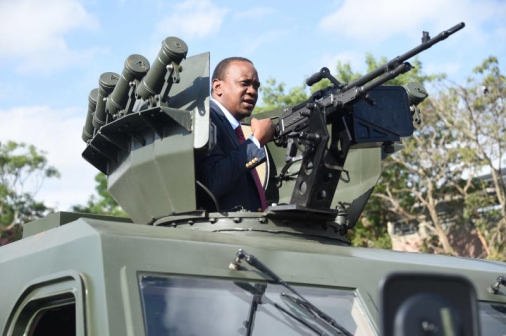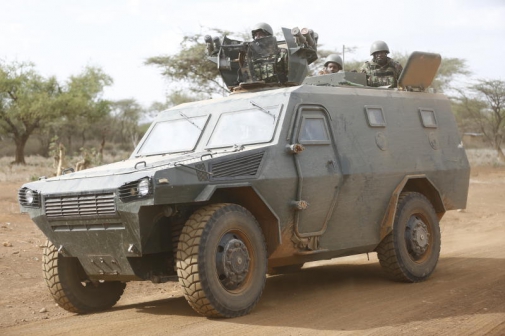
When 42 police officers were mowed down by cattle rustlers in Baragoi, there was a national outrage. Investigations later revealed that without protective armour, the officers were sitting ducks for the rustlers who had unrivalled knowledge of the “valley of death” because they had tactical advantage, having taken cover on raised ground.
And so, it was with a collective sigh of relief when President Uhuru Kenyatta commissioned a fleet of armoured personnel carriers (APCs) at the GSU headquarters in February last year. He said the APCs would wean the Kenya Police Service from dependence on the military or other security agencies for performance of their duties and go along way in securing the frontier areas of our country. Interior Cabinet Secretary Joseph Nkaissery described the new equipment as “a game changer in the fight against crime”.
The first test came on May 31 when five Administration Police (AP) officers and a civilian were killed in an Al-Shabaab ambush in Baure area of Lamu. The APs and a civilian were travelling in a MRAP (Mine-Resistant Ambush Protected) vehicle that hit a land mine. They managed to manoeuvre out of the vehicle, but were shot dead as they engaged the militias in a fire exchange.
Constable George Mwangi managed to sneak into a thicket and escaped the gun battle.
Then in April, a Chinese made NV4 armoured vehicle was ripped apart in Rhamu, Mandera. The car was patrolling within Elwak area when it was hit by an IED (Improvised Explosive Device). The three AP officers inside survived the attack.
Although the government maintains that the vehicles are of the recommended standards, police insiders and security analysts insist they are of low quality.
Brake failure of the armoured vehicles procured for police use could have been the early warning sign of an inferior shipment.
“Even before we reached Mandera, we noticed this peculiar problem of brake failure. It was discovered that the brake chambers were made of aluminum instead of iron, and that is why they tend to wear out fast,” said an officer who did not want to be named because he is not authorised to speak to the press.
Another police officer who was part of an initial team that was to travel to China to acquaint itself with the armoured vehicles claims Kenya got a raw deal, thanks to red tape at the procurement stage. According to him, the budgeted amount for the purchase of original armoured cars was slashed, forcing the Chinese to offer alternative models marching the amount available.
“The amount was not enough for the prototype vehicles. A solution had to be found and that is how we ended up with these tailor-made vehicles which are not ideal for our use,” said the officer.
Not tested
He said the armoured vehicles were not tested before and after shipment and that drivers and crew use manuals to operate them. The Nairobian was however was unable to independently verify these claims.

The armoured vehicles were part of a police upgrade programme estimated to cost Sh12 billion. President Uhuru Kenyatta on January 16, 2016 unveiled a fleet of 525 vehicles for use by police. They included the 25 MRAPs and 30 APCs, now labelled ‘death traps’ following the Lamu and Elwak attacks.
The MRAPs are designed to withstand IED attacks and ambushes. APCs are armed for self-defence and armoured to provide protection from shrapnel and small arms fire.
But National Police Service Spokesman George Kinoti says the design of the Chinese vehicles guaranteed the safety of occupants against explosive and ammunition pressure.
“In the Lamu attack, all the officers and the civilian came out of the mangled MRAP alive after it was hit by a land mine. It was just unfortunate that they were shot dead in the second timed ambush as they tried to battle with the attackers,” he explains.
While allaying fears that the armoured vehicles did not meet all the specifications, the spokesman said the chambers have been configured to protect occupants. It is understood that Grace Kaindi’s unceremonious sacking was partly linked to the purchase of the armoured cars. According to newspaper reports at the time, the former Deputy Inspector General in charge of Kenya Police was fired because of her hard line position on a Sh12 billion police upgrade project ahead of the 2017 General Election.
Influence the tender
The Star, quoting an “authoritative sources in the Office of the President”, reported that, “A top official in the Office of the President wanted Kaindi to influence the tendering process for the purchase of police equipment such as armoured cars and bulletproof vests. Kaindi is said to have declined the proposal.”
An officer who spoke to The Nairobian on condition of anonymity says, “Recall when Kaindi was sacked and try to connect the dots for yourself. She stood her ground, insisting we will not receive value for our money. Now see what is happening, police officers and civilians are being killed, and soon, the MRAPs and APCs will grind to a halt,” observed the officer.
The acquisition of what was billed as sophisticated hardware for the police for the first time was meant to stem frequent terrorist and banditry attacks.
Previously, it was only the military which had such vehicles at their disposal.
The vehicles have been distributed to personnel in the General Service Unit, Rural Border Patrol Unit and Rapid Deployment Unit for use in Baringo, Baragoi, Lamu, Garissa and Mandera, all areas classified as unsafe, paving way for security operations. But security analysts are now questioning why the armoured vehicles were never tested and the reluctance to go for the best quality. By resorting to shortcuts, the government got a raw deal, says Andrew Frankline, George Musamali and Richard Tutah.
Musamali, a former police officer, faults the procurement process, claiming it was never transparent. “In an ideal situation, they should have sampled the cars from different dealers and subjected each vehicle to tests within the different terrains in Kenya before settling for a dealer with the best quality,” states Musamali.
Interior CS Joseph Nkaissery and his PS Dr Karanja Kibicho remained mute on the matter. Calls and text messages to their phones went unanswered. Interior Ministry spokesman had not responded to our queries by the time of going to press.
 The Standard Group Plc is a multi-media organization with investments in media
platforms spanning newspaper print
operations, television, radio broadcasting, digital and online services. The
Standard Group is recognized as a
leading multi-media house in Kenya with a key influence in matters of national and
international interest.
The Standard Group Plc is a multi-media organization with investments in media
platforms spanning newspaper print
operations, television, radio broadcasting, digital and online services. The
Standard Group is recognized as a
leading multi-media house in Kenya with a key influence in matters of national and
international interest.



